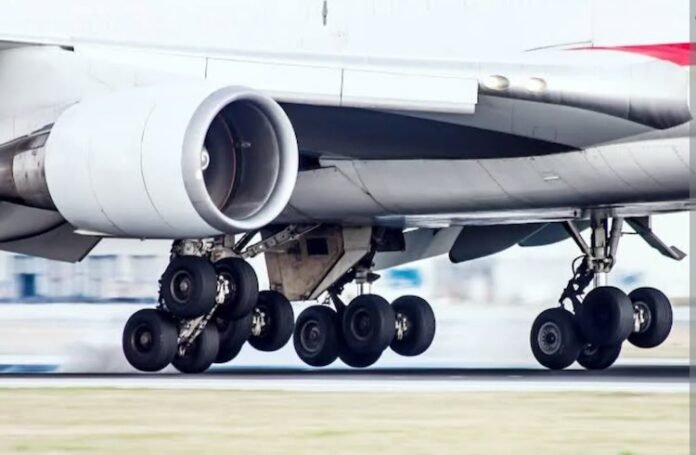The unsung heroes that make these moves possible are the airplane wheels, which you see when an aircraft taxis gently to the gate or touches down elegantly on the runway.
In addition to their obvious function during takeoffs and landings, these parts are essential to aviation operations’ general performance, safety, and effectiveness. You will discover the varied significance of airplane wheels in the complex dance of flying in this essay.
1. Supporting the Aircraft’s Weight: The Fundamental Load-Bearers
Airplane wheels are the load-bearers that support the weight of the complete aircraft, not just accessories. The wheels of your aircraft take the brunt of its bulk while it is on the ground, whether it is moving or not. It is not just a matter of structural integrity; these wheels’ capacity to sustain the weight of the aircraft is essential to the safety and effectiveness of every flying operation.
By distributing the aircraft’s weight uniformly throughout the landing gear, proper weight distribution helps avoid undue strain on any one component. This balanced load-bearing function becomes even more important when the wheels are subjected to dynamic stresses and impacts during takeoffs and landings.
2. Shock Absorption: Smoothing the Bumps in the Sky
Consider the impact forces that are produced during a landing, especially in difficult circumstances like erratic weather or on shorter runways. The integrated shock absorption systems found on airplane wheels are essential for reducing these forces. The wheels of your aircraft serve as shock absorbers as they touch down on the runway, absorbing the impact and lessening the force applied to the aircraft’s structure.
This capacity to absorb shocks protects the aircraft’s structural integrity and makes passenger travel easier and more pleasant. The precision with which airplane wheels are engineered allows them to absorb and diffuse impact forces, so your aircraft will land safely and smoothly even under unfavorable circumstances.
3. Facilitating Ground Maneuverability: Guiding the Aircraft’s Path
An aircraft’s wings take center stage while it is in the air, but Aircraft wheels are the feature that draws notice when it is on the ground. It takes skill to navigate on the ground, particularly in congested airports or on constrained taxiways. Propellers and other airplane wheels are arranged in different configurations to provide accurate steering and navigation.
The shape and positioning of these wheels directly impact how well the vehicle can pivot, turn, and handle tight turns. Airplane wheels are the unsung choreographers coordinating these motions, whether you’re taxiing to the runway, stowing away at the gate, or performing a controlled turn on the ground.
4. Brake Systems: Ensuring Controlled Deceleration
Imagine the speed at which an airplane rockets down the runway during takeoff and the necessary landing approach. The braking systems on the airplane wheels control this complex dance of acceleration and deceleration. These systems make sure that the aircraft decelerates safely and under control by often using cutting-edge technology like anti-skid and anti-lock brakes.
A vital component of landing safety is the efficient operation of these braking systems, particularly in poor weather or on shorter runways. High-performance braking systems on airplane wheels enable pilots to accomplish controlled and accurate landings, improving the aircraft’s overall safety and operating capabilities.
You May Like to Read: Pilot Logbooks – What are They & Why You Need One?
5. Materials and Construction: Engineering Excellence for Endurance
Not only are airplane wheels useful, but they are also amazing technical achievements. These wheels are made of high-strength alloys or forged aluminum, which are cutting-edge materials that are meant to last.
The enormous pressures and strains encountered during takeoffs, landings, and ground operations are considered when choosing the materials that go into their construction. The structural design of the wheel, which must strike a balance between strength and durability and weight concerns, also demonstrates technical perfection.
6. Integration with Avionics: Enhancing Safety through Sensor Technology
The significance of airplane wheels in contemporary aviation goes beyond their functional use. These wheels add to increased safety precautions since they are equipped with cutting-edge avionics and sensor technology. For instance, tire pressure monitoring systems (TPMS), which provide real-time data on tire conditions, are often incorporated into airplane wheels. Tire blowouts and failures may be avoided by using this technology, which enables pilots and ground workers to monitor tire pressure and identify any problems before they worsen.
Conclusion
Remember that every takeoff and landing is a symphony of exact motions orchestrated by the airplane wheels as you marvel at the wonders of flying. In addition to being physically present, these wheels serve as the quiet guardians of safety by supporting the load, cushioning impacts, enhancing maneuverability, permitting controlled deceleration, and combining cutting-edge technology.
You May Like to Read: 4 Amazing Tech to Complement Weather Routing

